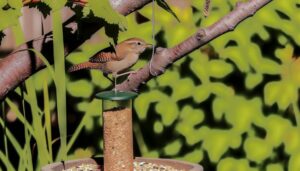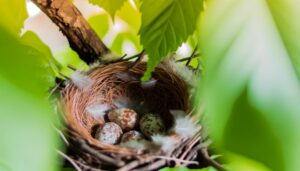House Sparrow Vs Carolina Wren – 3 Key Differences to Know
The House Sparrow (Passer domesticus) and Carolina Wren (Thryothorus ludovicianus) present key differences in their morphological, ecological, and behavioral attributes. The House Sparrow measures 14-16 cm with mainly brown-grey plumage, while the Carolina Wren, smaller at 12-14 cm, displays warm reddish-brown feathers.
Geographically, House Sparrows have a cosmopolitan distribution, thriving in urban areas globally, while Carolina Wrens are mainly found in southeastern U.S. wooded and suburban habitats.
House Sparrows are granivorous and form large flocks, whereas Carolina Wrens are insectivorous, more solitary, and highly territorial. Analyzing their adaptability reveals intriguing evolutionary strategies…

Key Takeaways
- House Sparrow is larger with a stout body, while Carolina Wren is smaller with a slender, curved beak.
- House Sparrow thrives in urban areas globally, whereas Carolina Wren prefers wooded and suburban habitats in the southeastern U.S.
- House Sparrows are non-migratory, but Carolina Wrens exhibit partial migratory behavior depending on winter severity.
- House Sparrows consume mainly grains and human-provided food, whereas Carolina Wrens primarily eat insects, fruits, and seeds.
- House Sparrows form large communal flocks, while Carolina Wrens are solitary and territorial, often seen in pairs.
Physical Characteristics
The physical characteristics of the House Sparrow (Passer domesticus) and the Carolina Wren (Thryothorus ludovicianus) exhibit distinct morphological differences that are critical for accurate species identification.
The House Sparrow typically measures 14-16 cm in length with a wingspan of 19-25 cm, featuring a stout body, short legs, and a robust, conical beak. Its plumage is mainly brown and grey, with males displaying black bibs.
In contrast, the Carolina Wren is smaller, measuring approximately 12-14 cm in length with a wingspan of 16-20 cm. It possesses a slender, curved beak, and its plumage is a warm, reddish-brown with a distinctive white supercilium (eyebrow stripe).
These morphological traits are essential for distinguishing between the two species in field observations.
Geographic Distribution
The geographic distribution of the House Sparrow (Passer domesticus) spans across multiple continents, mainly due to anthropogenic factors, whereas the Carolina Wren (Thryothorus ludovicianus) is mainly confined to the southeastern United States.
Urban versus rural presence reveals that House Sparrows exhibit a higher adaptability to metropolitan environments, contrasted by the Carolina Wren's preference for wooded and suburban habitats.
Comparative analysis of migration patterns indicates that House Sparrows are mostly sedentary, whereas Carolina Wrens exhibit partial migratory behavior in response to severe winter conditions.
Native Habitat Range
House Sparrows (Passer domesticus) inhabit urban and suburban areas across almost every continent, while Carolina Wrens (Thryothorus ludovicianus) are commonly found in the southeastern United States, favoring dense shrublands and forest undergrowth.
House Sparrows have a broad distribution, thriving in Europe, Asia, Africa, Australasia, and the Americas due to their adaptability to human-altered environments. Their range expansion has been facilitated by anthropogenic factors such as global trade and urbanization.
Conversely, Carolina Wrens exhibit a more confined geographic range, mainly in the southeastern U.S., extending northward only in milder climates. Their habitat preference includes deciduous forests, swamps, and overgrown fields, where they exploit available cover and food resources.
This habitat specificity underscores their limited geographic distribution compared to the cosmopolitan House Sparrow.
Urban Vs. Rural Presence
Given their distinctive habitat preferences, House Sparrows exhibit a pronounced urban presence, thriving in metropolitan areas globally, while Carolina Wrens mainly occupy rural landscapes, particularly in the southeastern United States.
House Sparrows (Passer domesticus) demonstrate high adaptability to dense human habitation, leveraging urban infrastructure for nesting and foraging. Their population density correlates strongly with urbanization metrics, with studies indicating a preference for buildings, parks, and other anthropogenic structures.
In contrast, Carolina Wrens (Thryothorus ludovicianus) favor wooded areas, brushlands, and suburban gardens, habitats abundant in rural settings. Their distribution is primarily influenced by the availability of dense vegetation and natural cover, which provide essential resources for nesting and protection.
This dichotomy underscores the species' differential adaptation to human-altered environments.
Migration Patterns Comparison
Analyzing the migration patterns of House Sparrows and Carolina Wrens reveals significant differences in their geographic distribution and seasonal movement behaviors.
House Sparrows (Passer domesticus) exhibit non-migratory patterns, maintaining stable populations across North America, Europe, and Asia.
Conversely, Carolina Wrens (Thryothorus ludovicianus) display partial migratory behavior, primarily within the southeastern United States. Data indicate that Carolina Wrens shift northward during mild winters and retract southward in harsher conditions, demonstrating a facultative migration strategy.
This contrasts with the House Sparrow's year-round residency, which is facilitated by their adaptability to urban environments and diverse food sources.
These variances underscore the ecological strategies each species employs to optimize survival and reproductive success in differing climatic conditions.
Songs and Calls
The vocalizations of the House Sparrow (Passer domesticus) and the Carolina Wren (Thryothorus ludovicianus) exhibit distinct acoustic patterns, characterized by specific frequency ranges and modulation techniques.
Significantly, the House Sparrow produces simpler, repetitive chirping calls, whereas the Carolina Wren's song is more complex, featuring a series of loud, melodious phrases.
Seasonal variations in singing behavior further differentiate the species, with the Carolina Wren displaying increased vocal activity during breeding months compared to the relatively constant call rate of the House Sparrow.
Distinct Vocal Patterns
Examining the distinct vocal patterns of the House Sparrow (Passer domesticus) and the Carolina Wren (Thryothorus ludovicianus) reveals significant differences in their song structures and call frequencies, which are essential for species identification and behavioral studies.
The House Sparrow's vocalizations consist mainly of simple, monotonic chirps, typically around 4-6 kHz, with minimal frequency modulation. In contrast, the Carolina Wren exhibits a more intricate song, characterized by rapid, melodious sequences ranging from 2-9 kHz, often with pronounced frequency sweeps and trills.
These vocal distinctions serve various ecological and social functions, including mate attraction and territorial defense. Detailed spectrographic analysis confirms that the Carolina Wren's song displays higher variability and complexity compared to the relatively repetitive calls of the House Sparrow.
Seasonal Singing Behavior
Seasonal variations in singing behavior between the House Sparrow and the Carolina Wren reveal adaptive responses to environmental and reproductive cues. House Sparrows exhibit moderate seasonal shifts, with peak vocal activity during the breeding season (April to August). Their song frequency is closely correlated with mating and territorial defense.
Conversely, the Carolina Wren demonstrates more pronounced seasonal singing, maintaining high vocal output throughout the year, with a notable increase during the winter months. This behavior is hypothesized to aid in territorial establishment and pair bonding during scarce resource periods. Data indicate that Carolina Wrens produce up to 3,000 songs daily in winter, compared to 1,000 in summer, underscoring the critical role of song in their survival strategy.
Nesting Habits
House Sparrows typically construct their nests in cavities, often utilizing man-made structures, whereas Carolina Wrens prefer more concealed locations like dense shrubs or natural crevices. This differentiation in nesting habits is pivotal for species-specific survival strategies.
Key points include:
- House Sparrows: Utilize urban environments, nesting in eaves, vents, and gutters.
- Carolina Wrens: Opt for secluded sites to avoid predation, often using dense foliage.
- Nest Composition: Sparrows use grasses and feathers; wrens incorporate twigs and leaves.
- Reproductive Output: House Sparrows may have 3-5 broods per year; wrens typically have 2-3.
- Nest Site Fidelity: Sparrows are more likely to reuse nests, while wrens often build new ones.
Understanding these nesting preferences helps in designing conservation and management strategies.
Diet and Feeding
In addition to their distinct nesting habits, House Sparrows and Carolina Wrens exhibit varied dietary preferences that reflect their adaptive survival mechanisms within their respective habitats.
House Sparrows (Passer domesticus) mostly consume a granivorous diet, favoring seeds from grasses and grains. They have, however, adapted to urban environments by incorporating anthropogenic food sources, including bread and other human leftovers.
Conversely, Carolina Wrens (Thryothorus ludovicianus) mainly adopt an insectivorous diet, consuming spiders, caterpillars, and beetles. This diet is supplemented occasionally with fruits and seeds. The metabolic demand for higher protein intake in Carolina Wrens underscores their reliance on arthropods, especially during breeding seasons.
These dietary distinctions highlight the ecological niches each species occupies and their respective foraging strategies.
Behavior and Interaction
Examining the behavior and interaction of House Sparrows and Carolina Wrens reveals significant differences in their social structures, territoriality, and communication methods.
House Sparrows (Passer domesticus) are highly social, forming large flocks and exhibiting communal roosting behaviors. In contrast, Carolina Wrens (Thryothorus ludovicianus) are more solitary and territorial, often seen in pairs defending their domain aggressively. Their communication strategies also differ markedly:
- House Sparrows: Utilize a variety of chirps and calls for flock cohesion.
- Carolina Wrens: Employ loud, melodious songs for territory defense.
- Territoriality: House Sparrows are less aggressive compared to the highly territorial Carolina Wrens.
- Social Structure: Sparrows display complex social hierarchies.
- Interaction: Wrens exhibit pair-bonding behaviors, unlike the more communal Sparrows.
Adaptability and Survival
Adaptability and survival strategies of Passer domesticus and Thryothorus ludovicianus demonstrate distinct ecological niches and resilience mechanisms that contribute to their persistence across diverse habitats.
Passer domesticus exhibits high adaptability through its synanthropic behavior, thriving in urban environments due to its generalized diet and nesting flexibility. Studies indicate a 25% increase in urban populations over the past decade.
Conversely, Thryothorus ludovicianus shows preference for wooded and brushy areas, relying on intricate vocalizations and territoriality to secure resources. Their foraging adaptability, particularly under varying climatic conditions, results in stable population trends.
Both species exhibit robust survival tactics, yet their differing ecological strategies underscore unique evolutionary adaptations, ensuring their continued coexistence in overlapping but distinct ecological niches.
Conclusion
The comparative analysis of the House Sparrow (Passer domesticus) and the Carolina Wren (Thryothorus ludovicianus) reveals distinct differences in physical characteristics, geographic distribution, vocalizations, nesting habits, diet, and behavior.
Both species exhibit notable adaptability, yet their survival strategies diverge notably. The House Sparrow, with its cosmopolitan presence, contrasts starkly with the more localized Carolina Wren.
Such divergences underscore the intricate dynamics of avian ecology and the evolutionary pressures shaping these two species' life histories.






